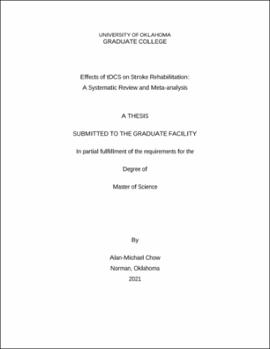| dc.description.abstract | Abstract
Transcranial direct current stimulation is a non-invasive brain stimulation technique in which a constant, weak electrical current is delivered to alter the excitability of neurons. It is believed that transcranial direct current stimulation may be able to aid in recovery of post-stroke patients, though, findings are inconclusive, which may be due to the heterogeneity of protocols. PURPOSE: The primary purpose of this systematic review is to determine the impact of total exposure time to tDCS, number of sessions or concurrent therapy types on the recovery of motor function in stroke patients. METHODS: Fifty-four studies were included in this review. Studies underwent risk of bias assessment and meta-analyses were conducted to determine the effects of tDCS exposure time on the recovery of motor function in individuals with stroke. RESULTS: There was a small, but significant improvement of post-intervention motor function evaluated with the Barthel Index when tDCS is added to the rehabilitation protocol. Similarly, there was an improvement in change scores of motor function evaluated by the Barthel Index and Upper Extremity Fugl-Meyer Assessment. However, there was no improvement in change scores of motor function evaluated with the Lower Extremity Fugl-Meyer Assessment or the Modified Ashworth Scale when tDCS was added to the rehabilitation protocol. Meta-analyses of post-intervention results revealed that combination of tDCS with conventional and assisted-type therapy improves motor function recovery evaluated by the BI, while miscellaneous therapy showed no improvements. Similarly, meta-analyses of change scores revealed significant effect of tDCS combined with conventional and assisted-type therapy on BI, and also revealed significant effect of tDCS combined with conventional and miscellaneous-type therapy on UE-FMA. There appears to be no dose-response relationship of tDCS. There appears to be no association between stimulation type with therapy type, MCID of the tDCS group or statistical significance between the tDCS and sham groups. However, there was an association between stimulation type and stroke duration. CONCLUSION: Transcranial direct current stimulation appears to be useful in improving motor function recovery of post-stroke patients as assessed by the Barthel Index and the Upper Extremity Fugl-Meyer Assessment. However, tDCS does not appear to be useful in improving motor function recovery as assessed by the Lower Extremity Fugl-Meyer Assessment or the Modified Ashworth Scale, perhaps due to low number of study inclusion. | en_US |
